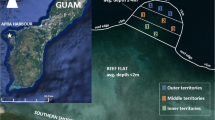Synopsis
There was partial spatial and complete temporal overlap of spawning by Etheostoma flabellare and E. nigrum in Marsh Creek, Wisconsin. E. flabellare tended to spawn at shallower depths than E. nigrum. Both species spawned over a greater range of depths in an area with few spawning sites (cavities under rocks or logs) than in an area where spawning sites were abundant. In the laboratory E. flabellare were able to prevent E. nigrum from occupying cavities they would have otherwise occupied. E. nigrum appear to be competitively inferior to E. flabellare in terms of spawning-site acquisition and retention, but possess several attributes that may allow them to persist in the presence of the latter.
Similar content being viewed by others
References cited
Balon, E.K. 1975. Reproductive guilds of fishes: a proposal and definition. J. Fish. Res. Board Can. 32: 821–864.
Baltz, D.M., P.B. Moyle & N.J. Knight. 1982. Competitive interactions between benthic stream fishes, riffle sculpin, Cottus gulosus, and speckled dance, Rhinichthys osculus. Can. J. Fish. Aquat. Sci. 39: 1502–1511.
Baumann, W.L. & M. Huels. 1982. Nests of the two-lined salamander, Eurycea bislineata. J. Herpetol. 16: 81–83.
Bradley, J.V. 1968. Distribution-free statistical tests. Prentice-Hall Inc., Englewood Cliffs. 388 pp.
Cadwallader, P.L. 1975. A laboratory study of interactive segregation between two New Zealand stream-dwelling fish. J. Anim. Ecol. 44: 865–875.
Constantz, G.D. 1979. Social dynamics and parental care in the tessellated darter (Pisces: Percidae). Proc. Acad. Nat. Sci. USA Philadelphia 131: 131–138.
Cooper, J.E. 1979. Description of eggs and larvae of fantail (Etheostoma flabellare) and rainbow (E. caeruleum) darters from Lake Erie tributaries. Trans. Amer. Fish. Soc. 108: 46–56.
Crocker, D.W. & D.W. Barr. 1968. Handbook of the crayfishes of Ontario. Univ. Toronto Press, Toronto. 158 pp.
Downhower, J.F. & C. Brown. 1980. Mate preferences of female mottled sculpins, Cottus bairdi. Anim. Behav. 28: 728–734.
Grant, J.W.A. & P.W. Colgan. 1983. Reproductive success and mate choice in the johnny darter, Etheostoma nigrum (Pisces: Percidae). Can. J. Zool. 61: 437–446.
Hlohowskyj, I. & A.M. White. 1983. Food resource partitioning and selectivity by the greenside, rainbow, and fantail darters (Pisces: Percidae). Ohio J. Sci. 83: 201–208.
Ingersoll, C.G., I. Hlohowskyj & N.D. Mundahl. 1984. Movements and densities of the darters Etheostoma flabellare, E. spectabile, and E. nigrum during spring spawning. J. Freshwater Ecology 2: 345–351.
Mantel, N. 1963. Chi-square tests with one degree of freedom; extensions of the Mantel-Haenszel Procedure. J. Amer. Stat. Assoc. 58: 690–700.
Mayden, R.L. & B.M. Burr. 1981. Life history of the slender madtom, Noturus exilis in southern Illinois (Pisces: Ictaluridae). Occasion. Pap. Mus. Nat. Hist., Univ. Kansas 93: 1–64.
Moodie, G.E.E. & M. Power. 1982. The reproductive biology of an armoured catfish, Loricaria uracantha, from Central America. Env. Biol. Fish. 7: 143–148.
Page, L.M. 1983. Handbook of darters. TFH Publications, Inc., Neptune City. 271 pp.
Page, L.M. & D.W. Schemske. 1978. The effect of interspecific competition on the distribution and size of darters of the subgenus Catonotus (Percidae: Etheostoma). Copeia 1978: 406–412.
Paine, M.D. 1984. Ecological and evolutionary consequences of early ontogenies of darters (Etheostomatini). Env. Biol. Fish. 11: 97–106.
Phillips, G.L., W.D. Schmid & J.C. Underhill. 1982. Fishes of the Minnesota region. Univ. Minnesota Press, Minneapolis. 248 pp.
Pianka, E.R. 1978. Evolutionary ecology, second edition. Harper and Row, New York. 397 pp.
Rohde, F.C. & R.G. Arndt. 1981. Life history of a coastal plain population of the mottled sculpin, Cottus bairdi (Osteichthyes: Cottidae) in Delaware. Brimleyana 7: 69–94.
Ryan, T.A., B.L. Joiner & B.F. Ryan. 1976. Minitab student handbook. Duxbury Press, Boston. 341 pp.
Stewart, M.M. 1968. Population dynamics of Eurycea bislineata in New York. J. Herpetol. 2: 176–177.
Stewart, M.M. & F.H. Pough. 1983. Population density of tropical forest frogs: relation to retreat sites. Science 221: 570–572.
Winn, H.E. 1958. Comparative reproductive behavior and spawning of fourteen species of darters (Pisces-Percidae). Ecol. Monogr. 28: 155–191.
Author information
Authors and Affiliations
Rights and permissions
About this article
Cite this article
Cochran, P.A., Lyons, J. Temporal and spatial patterns of spawning site use by two cavity-spawning darters in a Wisconsin stream. Environ Biol Fish 15, 131–139 (1986). https://doi.org/10.1007/BF00005428
Received:
Accepted:
Published:
Issue Date:
DOI: https://doi.org/10.1007/BF00005428




